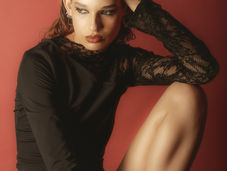Exhibitions at 180 The Strand
- Olivier Clément
- Oct 30, 2017
- 4 min read
October to December 2017
Tuesday - Saturday, 12-7pm; Sunday,12-6pm
Free Admission

‘Everything at once’ at 180 the Strand celebrates the 50th anniversary of the creation of the Lisson Gallery. It runs until the 10th of December in London’s home of fashion, Store Studios. The exhibition is named after American musician John Cage’s statement in 1966: “Nowadays everything happens at once and our souls are conveniently electronic (omniattentive).” These words can be used to describe and possibly criticise our current world and this is what ‘Everything at once’ seeks to do.
The exhibition, which is set up in collaboration with the Vinyl Factory, is aptly named. There is no correlation between the works of the 25 artists showcased at Store Studios; yet you will find several pieces which are conceptual, meaningful, and beautiful. The visit starts with a surprising and disturbing audiovisual installation by Ryoji Ikeba. His artwork, a bright and loud experience brought to you by a deafening sound system and blinding lights on the ground, takes you into an epileptic state. Some might love it and some might hate it, but one can be guaranteed to feel someway about it: while you can fully immerse yourself in it, you can also reach saturation and eventually reject the effect it has on you. You can be sure that it is a perfect taster for what is coming afterwards.
Numerous works are exposed, including some well-known artists such as Anish Kapoor, Ai Weiwei or Marina Abramović.

Kapoor’s “At the Edge of the World II” challenges your perception of space and lighting. This enormous work, which looks like a helmet, seems to suck you up when you stand in the middle of it, due to the use of burgundy pigments, erasing any sort of spatial placement. The colour of the edifice along with the darkness it produces means that one cannot exactly see into the artwork. One can gaze for long minutes at the helmet from below and yet not really see how it is built.
Next to it, two works by Ai Weiwei are exposed, including his almost 60 meter long wallpaper “Odyssey”. As he has in many of his recent works, Weiwei examines the refugee crisis our world is currently facing. This piece recounts the adventures of refugees trying to flee their own country, paralleling Homer’s epic. Modern and ancient figures are fighting for the same cause: messages such as ‘Open the border’, ‘Safe Passage’, and ‘No one is illegal’, are written on the frieze. This political work from Weiwei highlights the West’s rejection of refugees and relative passivity in light of the global crisis. Its sheer size as well as the repetitiveness of the images forces the visitor to confront the urgent situation.
Marina Abramović, the pioneer of performance art and one of the leading figures of the video art scene, has three of her clips projected. Every single one of them tests our senses, as we watch her challenge her own physical capacity. From “Freeing the Voice”, where she is lying with her head tilted backward until she loses her voice (taking over three hours – but only for a video of 35 minutes), to “Freeing the Body” where she is dancing for 55 minutes until her body collapses from exhaustion, and finally to the 50 minutes video “Freeing the Memory” where she challenges her mental capacity to recite every word she can remember in Serbian. Abramović’s will to show how far the human body can go seems to have no limit. Hearing her scream for 35 minutes might create a rather unpleasant feeling for the audience, and this is perfectly counterbalanced in the last video where words such as ‘night’, ‘pure’, and ‘milk’ flow together. In this last clip she makes us face the evidence that our language has a limit, and that words lack finality, purpose and meaning if there is no construction around their usage.
Other works from Richard Long or Shirazeh Houshiary also make the visit worthwhile. Richard Long’s

“Peloponnese Line” was painted onto one of the Store Studios walls and its size makes it quite impressive. Made of clay and mud, in the continuity of his “Red Earth Circle” made for the exhibition ‘Magiciens de la Terre’ in 1989 at the Centre Pompidou, the paintings have two distinctive forms separated in the middle of the artwork. This 60-metre long fresco brings a sense of serenity and appeasement to the exhibition following its eclectic start. Shirazeh Houshiary’s works follow the same logic. “Breath” is situated in an enclosed, darkened, and square room. Four screens are placed on each wall, projecting low intensity images of what looks like constellations of stars, with evocative chants from Buddhist, Christian, Jewish, and Islamic prayers. The potent atmosphere given by those four vocals sounds, correlated with the low luminosity, brings you to a peaceful and fulfilled physical and mental state – as if you were transported to a spiritual place.
The highlight for many visitors would surely be the last work exposed, in collaboration with the Serpentine Gallery, on the roof of 180 the Strand: Arthur Jafa’s “Love is the message, the message is death”. With this 7-minute video, Jafa gives his take on the modern ‘black American history’ backed by Kanye West’s gospel-inspired hip-hop track, Ultralight Beam. The violent and powerful images show police brutality towards African-Americans, including images of the Birmingham riot of 1963, and expressions of solidarity inside the African-American community. This video will move and transport you, while successfully accomplishing the artist’s will to ‘replicate the power, beauty and alienation of Black Music.’

For more information on the exhibition be sure to visit www.everythingatonce.com
























Comments